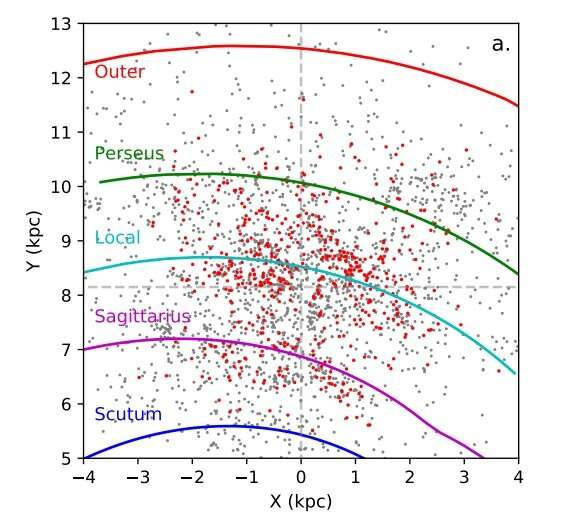March 17, 2022 report
Chinese astronomers discover more than 500 new open cluster candidates

By analyzing the data from ESA's Gaia satellite, Chinese astronomers have discovered 541 new open cluster candidates in the disk of our Milky Way galaxy. The finding, which includes median parameters of these cluster candidates, was detailed in a paper published March 10 on the arXiv pre-print server.
Open clusters (OCs), formed from the same giant molecular cloud, are groups of stars loosely gravitationally bound to each other. So far, more than 1,000 of them have been discovered in the Milky Way, and scientists are still looking for more, hoping to find a variety of these stellar groupings. Expanding the list of known galactic open clusters and studying them in detail could be crucial for improving our understanding of the formation and evolution of our galaxy.
Now, a team of astronomers led by Zhihong He of China West Normal University in Nanchong, China, reports the identification of over 500 objects that may be new open clusters. The finding is based on the analysis of data from Gaia's Data Release 2 (DR2) and Early Data Release 3 (EDR3).
"In this paper, we reported the finding of 541 new OC candidates based on our previous search in Gaia DR2 and made the new confirmations using Gaia EDR3," the researchers wrote in the study.
He's team used the pyUPMASK algorithm to estimate the membership probability of each input star from Gaia dataset. This is an open source software package compiled in the Python language following the development principle of Unsupervised Photometric Membership Assignment in Stellar Clusters (UPMASK). All in all, the astronomers provided the membership and median parameters for the new OC candidates, and also made classifications based on the color-magnitude diagrams (CMDs) and isochrone fittings.
According to the paper, the newly identified OC candidates are located in the Local, Sagittarius and Perseus arms and the inter-arm regions of the Milky Way. Most of them were found to be within 10,000 light years away from the Earth and within about 800 light years away from the galactic disk.
Furthermore, most of the 541 OC candidates reported in the study show small total proper motion dispersions, which seems to suggest that they may be genuine star clusters. When it comes to the metallicity gradient of these objects, it was found that the cluster candidates in the inner disk showcase higher metallicity than those in the outskirts. The research also found that in the case of the youngest OC candidates (less than 50 million years old), the metallicity gradient displays a larger decrease in the vicinity of our solar system.
Summing up the results, the scientists underlined that their discovery shows how incomplete the OC sample from the Gaia data is. They expect that further investigation of the EDR3 dataset will yield more detections of OC candidates.
More information: Zhihong He et al, New Open Cluster candidates Found in Galactic Disk Using Gaia DR2/EDR3 Data. arXiv:2203.05177v1 [astro-ph.GA], arxiv.org/abs/2203.05177
© 2022 Science X Network



















